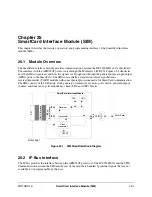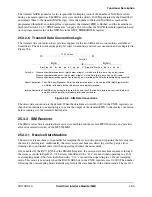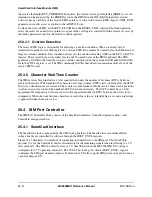
Functional Description
MOTOROLA
SmartCard Interface Module (SIM)
25-11
Figure 25-7. Receive State Machine Diagram
25.3.3.2 Data Sampling / Voting
The receive state machine runs at the receiver clock rate (RCV_CK). This clock is oversampling the
received data at a sample rate of either 16X or 12X. For each input bit, the receive state machine captures
three samples. A majority voting algorithm is then applied to determine the value of the bit received. The
value common to two or more of the samples is selected as the bit value in the receive shift register.
25.3.3.3 Start Bit Detection
The SIM receive input is defined as high when not active. The data transmission is defined as beginning
with a low pulse for a bit duration. This is called the start bit. The receive state machine is responsible for
detecting and validating the start bit. The receive state machine samples the start bit three times and uses a
majority voting scheme to determine if the start bit is valid. This effectively filters out any low receive
inputs shorter than one RCV_CK period. Figure 25-8 shows a typical SIM data transaction with the start
bit identified.
Figure 25-8. Start Bit Diagram
25.3.3.4 Parity Error Detection
The receive state machine is responsible for detecting parity errors in the received data. Data is always
transmitted with even parity, except when in inverse convention mode. In inverse convention mode, all
data bits and the parity bit are complemented making the data parity appear to be odd. The parity bit is
defined as the 10th bit of the received data. The parity of the 2nd through 10th received bits is calculated
by the receiver parity logic. This logic determines if the parity of the 9 received bits is correct. Figure 25-9
shows a typical SIM data transaction with the parity bit identified.
RCV16x_13
RCV12x_9
RCV16x_14
RCV12x_10
RCV16x_15
RCV12x_11
RCV16x_9
RCV12x_6
RCV16x_10
RCV12x_7
RCV16x_11
RCV12x_8
RCV16x_12
RCV16x_6
RCV16x_2
RCV16x_5
RCV12x_3
RCV16x_7
RCV12x_4
RCV16x_8
RCV12x_5
RCV16x_1
RCV12x_1
RCV16x_3
RCV12x_2
RCV16x_4
RCV16x_16
RCV12x_12
Start
Byte
i
Byte
i+1
LSB
MSB
Stop Bits
P
Start
Start Bit
Summary of Contents for DragonBall MC9328MX1
Page 68: ...1 12 MC9328MX1 Reference Manual MOTOROLA Introduction ...
Page 86: ...2 18 MC9328MX1 Reference Manual MOTOROLA Signal Descriptions and Pin Assignments ...
Page 116: ...3 30 MC9328MX1 Reference Manual MOTOROLA Memory Map ...
Page 126: ...4 10 MC9328MX1 Reference Manual MOTOROLA ARM920T Processor ...
Page 160: ...8 8 MC9328MX1 Reference Manual MOTOROLA System Control ...
Page 272: ...13 32 MC9328MX1 Reference Manual MOTOROLA DMA Controller ...
Page 281: ...Programming Model MOTOROLA Watchdog Timer Module 14 9 ...
Page 282: ...14 10 MC9328MX1 Reference Manual MOTOROLA Watchdog Timer Module ...
Page 300: ...15 18 MC9328MX1 Reference Manual MOTOROLA Analog Signal Processor ASP ...
Page 438: ...18 16 MC9328MX1 Reference Manual MOTOROLA Serial Peripheral Interface Modules SPI 1 and SPI 2 ...
Page 478: ...19 40 MC9328MX1 Reference Manual MOTOROLA LCD Controller ...
Page 574: ...21 32 MC9328MX1 Reference Manual MOTOROLA Memory Stick Host Controller MSHC Module ...
Page 598: ...23 16 MC9328MX1 Reference Manual MOTOROLA Real Time Clock RTC ...
Page 670: ...24 72 MC9328MX1 Reference Manual MOTOROLA SDRAM Memory Controller ...
Page 726: ...25 56 MC9328MX1 Reference Manual MOTOROLA SmartCard Interface Module SIM ...
Page 736: ...26 10 MC9328MX1 Reference Manual MOTOROLA General Purpose Timers ...
Page 854: ...29 18 MC9328MX1 Reference Manual MOTOROLA I2C Module ...
Page 900: ...30 46 MC9328MX1 Reference Manual MOTOROLA Synchronous Serial Interface SSI ...
Page 942: ...32 26 MC9328MX1 Reference Manual MOTOROLA GPIO Module and I O Multiplexer IOMUX ...
















































